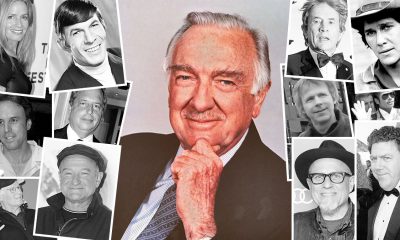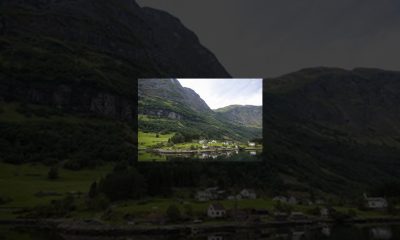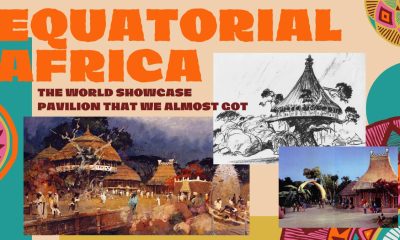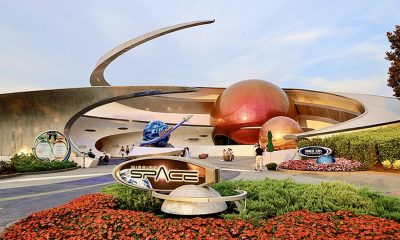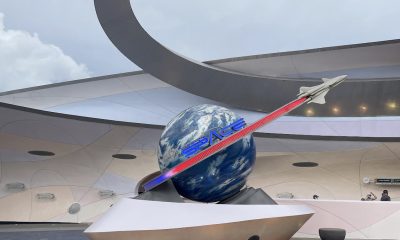Theme Parks & Themed Entertainment
History of Epcot’s World ShowPlace & Millennium Celebration
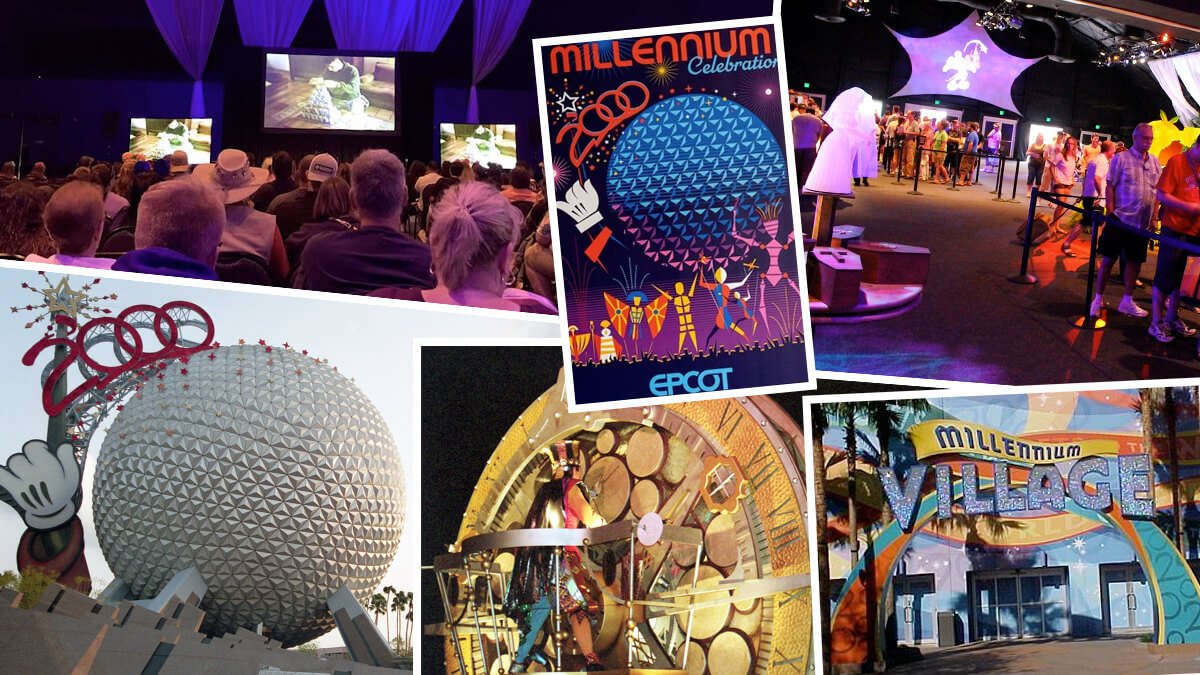
It’s 1996. And Disney Parks & Resorts is already thinking about how it should handle the Millennium.
Not that Y2K bug thing, mind you.
Y2K and the Disney Theme Parks
Do you remember how – back in the late 1990s – there were people who were absolutely terrified that, due to a flawed bit of computer code … Well, at the very second the world transitioned over from 1999 to 2000, everything that was run by computer would suddenly shut down. Including the North American power grid.
This was something that many corporations – including The Walt Disney Company – took very, very seriously in the lead-up to the Millennium. The Mouse actually set up a dedicated task force of 800 employees to investigate the Disney Company’s possible exposure to a Y2K bug threat and then put together a response plan.
One element of Disney’s Y2K bug response plan was – should the North American power grid actually fail at the stroke of midnight on December 31, 1999 – each of Disney’s stateside parks had dozens of emergency lights & back-up generators on hand. These items were stashed backstage at the Parks (out of sight of the Guests, of course), ready to be deployed at a moment’s notice. Just in case the country’s power grid really did suddenly collapse that night.
Shutting Down Every Attraction on 12/31/1999
And speaking of December 31, 1999, how many Disney theme park fans remember how – on that night – the Mouse shut down every single ride, show & attraction at its stateside theme parks 15 minutes prior to midnight and then held those things in place / in check for 30 minutes or so? They did this until it was clear that the North American power grid hadn’t actually collapsed and that every computer on the planet hadn’t really gone haywire.
“Better safe than sorry” was the thinking among the Park’s Ops Team. They didn’t want Guests stuck on Disneyland’s or WDW’s attractions should the Y2K bug prove be a very real thing.
Anyway … A half hour after the stroke of midnight on what-was-now-January 1st, 2000, all of those rides, shows & attractions at Disney’s stateside parks were back up & running again. Loaded with happy, still alive Guests.
Mind you, the Mouse never admitted publicly that the reason they’d shut down all of the rides, shows & attractions at its stateside theme parks just prior to midnight on December 31, 1999 was out of Y2K bug-related safety concerns. What Disney spokespersons said instead was – in essence – “ … we just to be sure that all of our Guests got the chance to see that night’s special fireworks display.”
Yeah. Right.
Millennium Celebration for Walt Disney World and Disneyland
Back to 1996 now.
What The Walt Disney Company was most concerned about – as it looked ahead to the Millennium was — … Well, to borrow a phrase from a very famous Prince song, figure out what to do in California & Florida when Disney theme park fans wanted “ … to party like it’s 1999.”
On the West Coat, given that Disney’s California Adventure would still be under construction at the start of the Millennium (That theme park wouldn’t actually open to the public ‘til February 8, 2001. And given that the Disneyland Parking Lot would close on January 21, 1998 to then make room for DCA … Well, the rest of that Resort would largely be a maze of construction fences when December 31, 1999 finally arrived), a one-night-only party seems like the smartest way to go.
Whereas in Florida … The thinking is – instead of a one-night-only party – Walt Disney World should explore the idea of a staging a months-long Millennium celebration. Something that could start in 1999 and then roll on into 2000.
Quick aside here: WDW’s PR team just loved this idea. Largely because – by the late Spring / early Summer of 1999 — the newness & excitement associated with Disney’s Animal Kingdom (That theme park was due to open in April of 1998) would have begun to wear off.
Selecting Epcot for the Millennium Celebration at Walt Disney World
As to which park should host Walt Disney World’s Millennium Celebration … Well, that was kind of a gimmee back then. Largely because — while Epcot was the park at the Walt Disney World Resort with the second highest attendance levels (Magic Kingdom was first) — it was also [at that time, anyway] the least profitable park on property.
I know that that’s strange to hear today. Especially given the hand-over-fist money that the WDW Resort now makes off of those super-sized, extended versions of Food & Wine and Flower & Garden. But you also have to remember that today’s story starts back in 1996. And the …
- 1st Flower & Garden wasn’t held til April of 1994 (And even then, it was just five weeks long)
- Likewise the 1st Food & Wine wasn’t held ‘til September of 1996 (and it was just 30 days long)
- Interestingly, the 1st Holidays Around the World / now International Festival of the Holidays debuted that very same year. In November of 1996 to be precise (it also was just five weeks long)
- And Epcot’s International Festival of the Arts is the newest of the bunch. It debuted just 5 years ago in January of 2017 (and was also only five weeks long)
So you have to understand that these massive money makers (as we know them today, anyway) weren’t really in place back then. Which is why Epcot – which then had to largely rely on its original assortment of attractions to lure WDW visitors through its turnstiles – was the least profitable park on property.
Anyway … Disney Parks & Resorts hoped to turn this situation around (at least for 15 months or so) by making Epcot Center the center of WDW’s Millennium Celebration. Which was supposed to get underway in October of 1999 and then run at least through December of 2000.
Just so you know, though: There was a secondary agenda being serviced here as well … Disney Parks & Resorts wanted to use WDW’s Millennium Celebration as a way to reintroduce the world to a new, fun version of Epcot …
Epcot 2.0
Sound familiar? Yep, that is exactly what Walt Disney World had also hoped they’d be able to do with the Resort’s 50th anniversary celebration which began back on October of 2021. Reintroduce the world to the brand-new, fun version of Epcot 2.0. (They say no good idea ever dies at Disney. But wasn’t it Santayana who said that “ … a fanatic is someone who redoubles their effort when they’ve forgotten their original aim” ? )
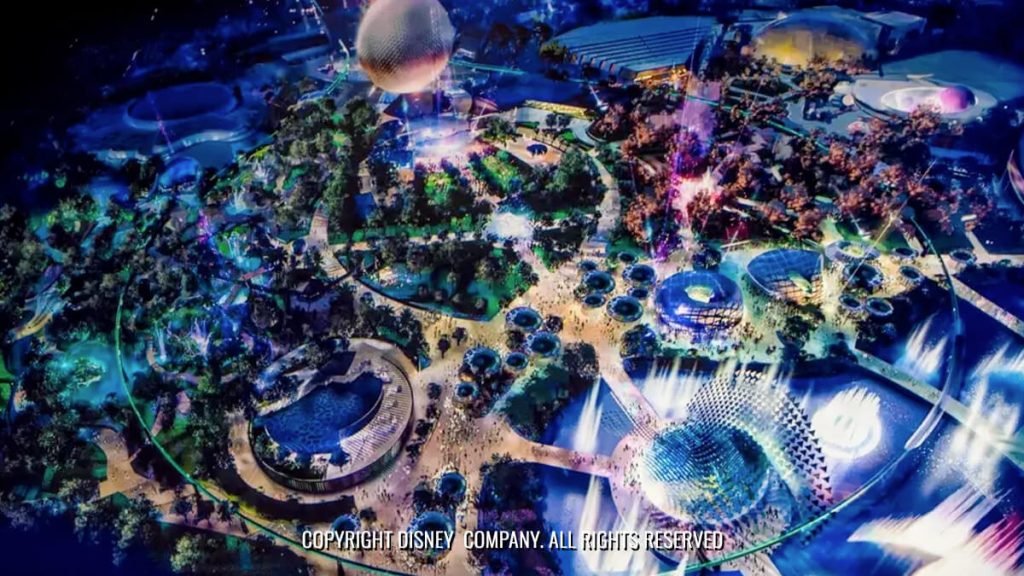
Of course, when it came to the launch of the brand-new, fun version of Epcot 2.0, the pandemic & its impact on the labor force and worldwide supply chains kind of blew that very ambitious plan right out of the water. So instead of a bright new shiny version of Walt Disney World’s science & discovery park being in place just in time for the launch of this Resort’s 50th anniversary celebration back in October of 2021 … What we got instead is a handful of new rides, shows & attractions like “Remy’s Ratatouille Adventure,” “HarmonioUS,” “Guardians of the Galaxy: Cosmic Rewind,” “The Creations Store,” “Space 220,” “The Connections Café & Eatery,” and – soon – “Moana: The Journey of Water” opening one at a time in kind of a scattershot fashion … Which (let’s be honest here) didn’t have nearly as big an impact / make nearly as big a splash than as if all of these new rides, shows & attractions had managed to come online in the exact same window of time (i.e., late Summer / early Fall of 2021. Just in time for the start of WDW’s 50th anniversary celebration).
Quick aside: I want to be clear here: This wasn’t poor planning on Disney’s part. Nobody could have ever foreseen that a once-in-a-century pandemic would come over the hill and then disrupt WDW’s a-decade-in-the-making 50th anniversary plans. Epcot’s still limping along through its reimagining right now. Which — I’m now hearing –should largely be complete by 2024 (This is when the Play! Pavilion, CommuniCore Hall & Communicore Plaza are supposed to finally come online. We’ll get to those latter two projects in the back half of today’s story).
Prepping Epcot for WDW’s Millennium Celebration
Back to 1996 and the Resort’s advance prep & planning for WDW’s Millennium celebration now … There was a method to the Imagineers’ madness. All of the changes that were to be made to Epcot out ahead of October of 1999 (the target date for the launch of this park’s 15 month-long Millennium celebration) had a very deliberate purpose.
- That giant “Sorcerer Mickey” arm which was erected over Spaceship Earth was supposed to send a message to Guests that Epcot was now far more magical & fun.
- The “Tapestry of Nations” parade (which was presented twice daily, once starting at 6:30 p.m. and then a second presentation of the same parade starting at 8:10 p.m.) was supposed to compel Guests to stay in Epcot long enough each day to actually view that parade. And while these people were killing time waiting … Well, they’d either have to shop or grab a meal (Which would then hopefully help with Epcot’s least-profitable-theme-park problem) …
- Then – to absolutely make sure that people lingered as long as possible inside of Epcot while the Resort’s Millennium Celebration was being presented – WDW Entertainment rolled out a brand-new edition of “Illuminations,” “Reflections of Earth.” Which was a significant upgrade of the previous nighttime show that had been staged out on World Showcase Lagoon. With giant torches erected all along the esplanade and the Inferno Barge literally starting this show with a bang.
The hope was that people would have such a great time at WDW’s 15 month-long Millennium Celebration that they’d then want to commemorate this special occasion. This is why the Imagineers then built the “Leave a Legacy” plaza directly in front of Spaceship Earth.

This retail initiative was a sequel of sorts to those hugely popular “Walk Around the World” pavers that had been sold over at the Magic Kingdom as part of WDW’s 25th anniversary celebration.
FYI: WDW’s 25th anniversary celebration was also originally supposed to be just a 15 month-long celebration, running from October of 1996 through December of 1997. But that event proved to be so popular with WDW visitors that the Resort’s 25th anniversary celebration got extended another three months. All the way to March of 1998.
And to be honest, if the Resort could have gotten away with it, they’d have extended WDW’s 25th anniversary celebration event even further than that. But they were forced to finally shut those festivities down in March of 1998, largely because Disney’s Animal Kingdom would be opening in late April of that same year. And that theme park’s opening was supposed to be the primary focus of the WDW Resort’s promotional efforts for the bulk of 1998).
“Leave a Legacy” at Epcot
Back to the “Leave a Legacy” retail program now … The Imagineers built a Stonehenge-like plaza in front of Spaceship Earth which had space for 750,000 tiles that could then feature the smiling faces of Guests who had just attended Epcot’s Millennium Celebration (Which the Company really hoped would eventually turn into a WDW 20th anniversary-like success. Which would have then forced the Resort to extend its 15th month-long Millennium celebration another three months into the late Winter / early Spring of 2001).
That wasn’t to be, though. “Leave a Legacy” ultimately proved to be something of a disappointment. Only 440,000 tiles were sold over the course of Epcot’s Millennium celebration. (I’m told that this was because most people didn’t like how their likenesses on the finished tiles turned out AND because it was then hard to find your “Leave a Legacy” tile once it was finally put in place in that stone garden in front of Spaceship Earth).
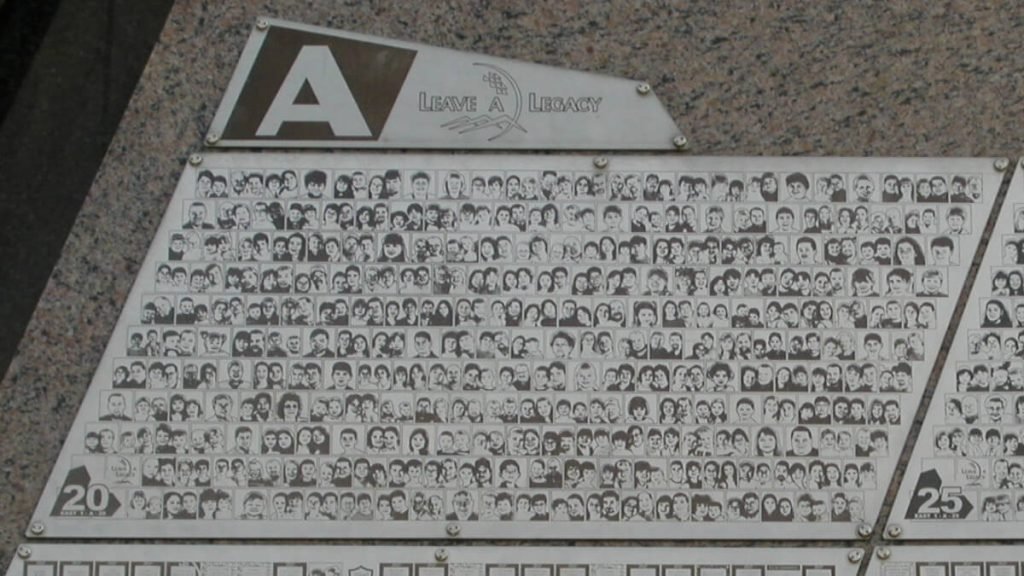
Terry Dobson (Walt Disney Imagineer)
We’ve talked about what Walt Disney World was going to do in order to get Guests to linger at Epcot in the late afternoon / early evening during that Resort’s Millennium Celebration with that one-two punch of “Tapestry of Nations” and “Illuminations: Reflections of Earth.” But what was supposed to compel people to visit that theme park earlier in the day while this 15-month-long event was going on?
That was the assignment that was handed to Terry Dobson. Who – at this point – was a veteran Show Producer at Walt Disney Imagineering.
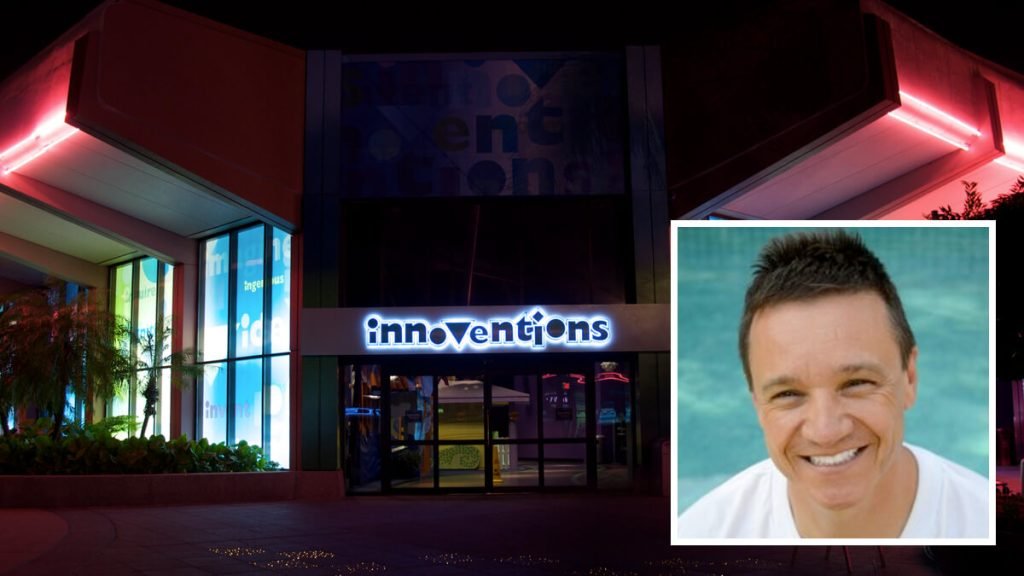
Credit: apu.edu
Innoventions at Epcot
From January of 1993 through October of 1994, Terry had been the guy who rode herd on the transformation of CommuniCore West into Innoventions. That 100,000 square foot exhibition officially opened in Epcot’s Future World section in July of 1994 and featured displays by all sorts of major American corporations. Among them AT&T, GE, GM, Motorola, Honeywell, IBM, Apple, Silicon Graphics, and Lego.
That Future World display proved to be so popular that the team who was working on reimagining Disneyland’s Tomorrowland area back in the late 1980s / early 1990s then said “Hey, we wanted an Innoventions too.”
Disneyland Innoventions
So from February of 1996 through May of 1998 (which is when Disneyland’s new version of a New Tomorrowland finally opened), Terry did the exact same thing. Which was take a pre-existing structure (In this case, the Carousel of Progress theater-go-round building) and then turn it into a space where … Well, here’s a piece of Disney speak for you …
… deliver corporate messages through family play experiences through a mixture of high-tech, low-tech and no-tech hands-on exhibits.
This time around, Dobson delivered a 30,000 square foot exhibition space that featured displays by for SAP, Compaq, Honeywell, AT&T, GM and Kaiser Permanente. That last sponsor was a throwback to an opening day attraction at Disneyland.
Anyway, just like the East Coast version of Innoventions, the West Coast version of this exhibit proved to be hugely popular with Guests. Which is why – when Dobson finally returned to his office at Imagineering headquarters in Glendale – he found WDW’s the Millennium Celebration team waiting for him.
Epcot’s World ShowPlace and Millennium Village
They told Terry “Hey, how’d you like to tackle another Innoventions-like project with lots of displays? Only this time, you’ll be working with countries, rather than corporations. Which – I’m sure — will be far easier to deal with. But the upside is … At least this time, you’ll be working with a brand-new 65,000 square foot building.”
Did I say “building” ? To be honest here, the World ShowPlace (that’s what this 65,000 square foot structure eventually became known as. But let’s not get ahead of ourselves here, shall we?) is a tent. A very large, supposed-to-be-temporary tent.
Those tents that now house Pete’s Silly Sideshow & Big Top Souvenirs over WDW’s Magic Kingdom, which were originally erected back in 1988 as part of Mickey Mouse’s 60th birthday celebration and then only supposed to be in place for a year), there’s nothing quite so permanent as a supposed-to-be-temporary tent at Walt Disney World.
As Terry Dobson began actively developing World ShowPlace and the Millennium Village display that was supposed to eventually be staged inside of this 65,000 square foot temporary building / tent, this Imagineering vet quickly realized that he was now serving two masters.
By that I mean: WDW Resort officials wanted the Millennium Village to be this must-see spectacle. A colorful gathering which represented over 50 nations from around the globe that would then compel people to fly on down to Orlando and check this exhibition out during its 15-month-long run. Disney World’s only creative caveat going into this project was that Terry NOT include any displays from countries that already had a pavilion out along the shores of World Showcase Lagoon. Only new & different nations, please.
Whereas Epcot’s management team … Well, they went into the Millennium Village / World ShowPlace project with a somewhat different agenda. They were much more intrigued by how this 65,000 square foot building / tent / supposedly-temporary structure could possibly be used AFTER WDW’s 15-month-long Millennium Celebration was over.
Rain’s Impact on Festival Attendance at Epcot
By that I mean: At this point in that theme park’s history, Epcot had been running its seasonal Flower & Garden, Food & Wine, and Holidays Around the World festival for a few years now. And while all three of these seasonal events had shown huge profit potential … Well, the problem was that Flower & Garden, Food & Wine as well as Holidays Around the World was that they were largely events that were staged outdoors. Which mean that all it took to tank that day’s attendance at Epcot (and thereby significantly undermine the profit potential of that particular seasonal event) was one of Central Florida’s famous torrential rainstorms.
So – to mitigate this situation – Epcot wanted a big, new, under-cover venue. Some place where — even when it was pouring outside – Guests could then gather indoors and still enjoy food from around the globe, or listen to Disney’s own horticulturists tell them how to improve their gardens at home, or shop for pieces of art that these tourists could then haul home.
Constructing Epcot’s World ShowPlace
And to get this enormous, new, under-cover venue … Epcot was willing to make some pretty big sacrifices. They were willing to give up that expansion pad between World Showcase’s Canada Pavilion and the UK Pavilion (This is where – back when EPCOT Center was originally being designed – the Imagineers envisioned another international pavilion eventually rising up) so that a long, wide walkway could then built to allow WDW visitors access to the largely-backstage area where World ShowPlace was being built.
Of course, this was kind of costly. Which is why Epcot’s managers reached out to Walt Disney World’s Special Events / Corporate Events office. And then basically said “The Imagineers are now designing a brand-new venue at our theme park that you guys are probably going to want to start using once WDW’s Millennium Celebration is over. Do you want to give them any input / some notes?”
And indeed Disney World’s Special Events / Corporate Events office did. Seeing World ShowPlace as a place where – in the not-so-distant future – they could soon begin staging super-sized dessert parties for companies that were holding their annual conventions on WDW property … Disney World’s Special Events / Corporate Events office asked that the plans for World ShowPlace include:
- A giant professional prep kitchen (which was supposed to have its loading dock deliberately orientated out towards Epcot’s perimeter road. Which would then make food & supply deliveries to this super-sized facility far simpler)
- An enormous bathroom just off of the theme-park-facing entrance to this 65,000 square foot structure. This was to be at the top of that walkway up from World Showcase Promenade. Which – again – had been built between Epcot’s UK pavilion & the Canada pavilion.
The idea here was … Well, if you were having some sort of corporate event with an open bar, you’d then have a place where all of these deep-pocketed / paying-with-their-per-diem Guests could quickly pee before they then walked out towards World Showcase Lagoon to watch a presentation of “Illuminations: Reflections of Earth.”
- Next is an element that’s crucial for any building-of-size that was being built in Central Florida today. And that’s no less than six enormous professional-grade air conditioning units, which were set up around the perimeter of this enormous tent-like structure. Which would virtually guarantee that – no matter how many people were crammed into this building at any one time dressed in formal business attire – they’d all always stay cool.
- And speaking of keeping things cool (or should I say “wet”?), a network of sprinklers were to be built into the roof line of the again-supposed-to-be-temporary World ShowPlace.
These sprinklers were be turned on every night just prior to the start of “Illuminations: Reflections of Earth.” So that – should a stray firework shell ever accidentally come down on top of this massive tent-like structure as this nightly fireworks / laser extravaganza is being presented – World ShowPlace wouldn’t then go up in flame.
Now please keep in mind that all of the above were permanent structures that were then added to the plans of what was originally supposed to be just a temporary structure. Which obviously added to the cost of originally building World ShowPlace but also – further on down the line — made this Epcot addition that much more valuable & versatile as a venue for corporate & special events.
“Millennium Village”
But before any of that stuff could happen, Terry Dobson had to first deliver that Innoventions-like “Millennium Village” display. Which needed to be up & running by October of 1999.
And remember how Terry’s original marching orders were “We want a spectacle. A massive display featuring over 50 nations from around the globe”? Well, recruiting corporations to show off their latest & greatest hi-tech wares in Innoventions was a lot easier than persuading countries to come take part in Epcot’s Millennium Village exhibition. In the end, Dobson was only able to persuade 24 nations to set up displays inside of World ShowPlace.
And even then, a lot of countries weren’t willing to come be part of the “Millennium Village” unless they were then allowed to cut corners.
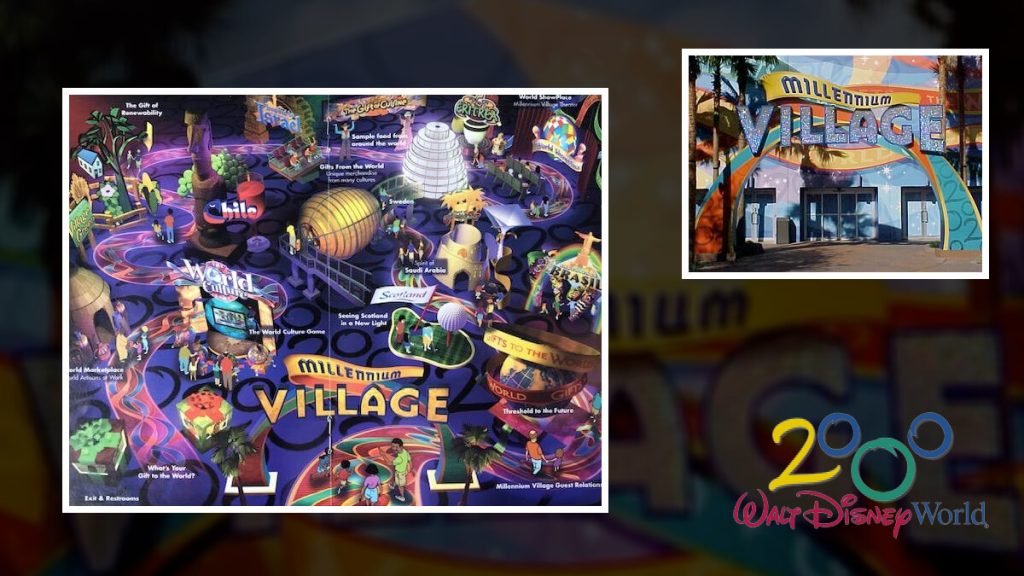
Sweeden
Case in point: Sweden. While this Nordic country was genuinely interested in taking part in Epcot’s Millennium Celebration, Swedish officials weren’t all that eager to spend a large sum of money to build a brand-new display for Disney World. Which is why they asked permission to just recycle the “Four Seasons of Sweden” exhibit that Swedish officials had originally built for Expo ’98 (which had been held the year previous in Lisbon, Portugal) and erect those 30 foot-tall egg-shaped biodomes inside of World ShowPlace. Dobson said “Yes.”
Jerusalem
One country that Terry maybe – in hindsight – wishes that he hadn’t recruit for this event was Israel. Who then presented the somewhat controversial “Journey to Jerusalem” simulator ride in that country’s section of the Millennium Village.
“And what was so controversial about Israel’s ‘Journey to Jerusalem’ ride?,” you ask. Well, this motion-based experience gave WDW visitors a simulated tour of that Holy City through various periods in history.
And because Jerusalem is considered a holy city by a number of religions, this motion-based experience became a hot button issue even before Epcot’s Millennium Village officially opened in October of 1999.
The Arab League was especially incensed by the “Journey to Jerusalem” ride. They all but accused The Walt Disney Company of helping Israel to reinforce that country’s long-held claim that Jerusalem was actually Israel’s capital. Which had – of course — been a bone of contention in this region ever since Israel had first declared its independence back in May of 1948.
Disney (which had offered some creative input when the “Journey to Jerusalem” ride was first put into development) insisted that this motion-based simulator was apolitical. But when word got out that Israel’s Ministry of Foreign Affairs – rather than its Ministry of Tourism – had contributed some $1.8 million towards the cost of building this $8 million attraction … Well, that then gave this controversy some additional oxygen.
As a direct result of this bout of bad publicity, WDW’s Millennium Celebration got off to a somewhat rocky start. Disney tried to paper over this controversy by bringing Maya Angelou & UN Secretary General Kofi Annan in late October of 1999 to give the Millennium Village their official blessing.
World ShowPlace After Millennium Celebration
Once Epcot’s Millennium Celebration officially ended in December of 2000, Epcot officials and the folks in charge of WDW’s Special Events / Corporate Events office finally got to use World ShowPlace for the purposes they had originally envisioned. Which was as a large under-cover space where various aspects of Flower & Garden, Food & Wine, Festival of the Holidays & Festival of the Arts could be presented indoors. And – when those seasonal events aren’t being staged – WDW’s Special Events / Corporate Events office could then make this very same space available to companies that are staging their conventions down in Orlando.
The downside is … A lot of these corporations over the past 20+ years have already staged their company’s events inside of World ShowPlace. And lately, they’ve been looking for someplace new on WDW property where they can then stage these events / hold their after-convention cocktail parties.
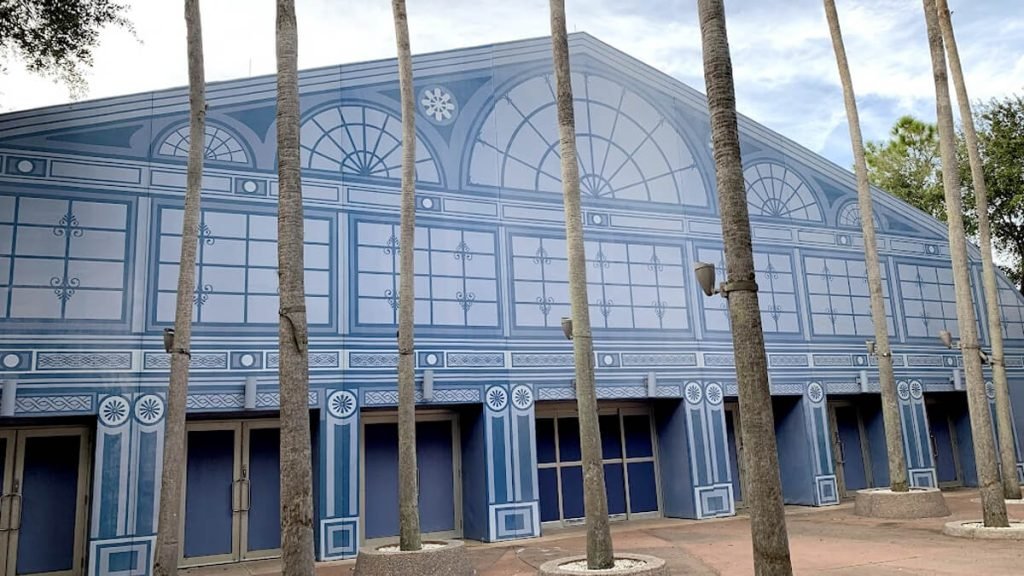
“Park in the Sky”
Which brings us to that “Park in the Sky” project which was first announced at the Disney Parks & Resorts panel that was held at the D23 Expo back in August of 2019. This was when Bob Chapek first revealed that Epcot’s World Showcase was going to be broken up into three distinct neighborhoods:
- World Discovery
- World Nature
- and World Celebration
And serving an anchor for World Celebration was supposed to be this brand-new pavilion, a three story-tall structure that would be both a venue for live events as well as the home base for Epcot’s signature festivals.
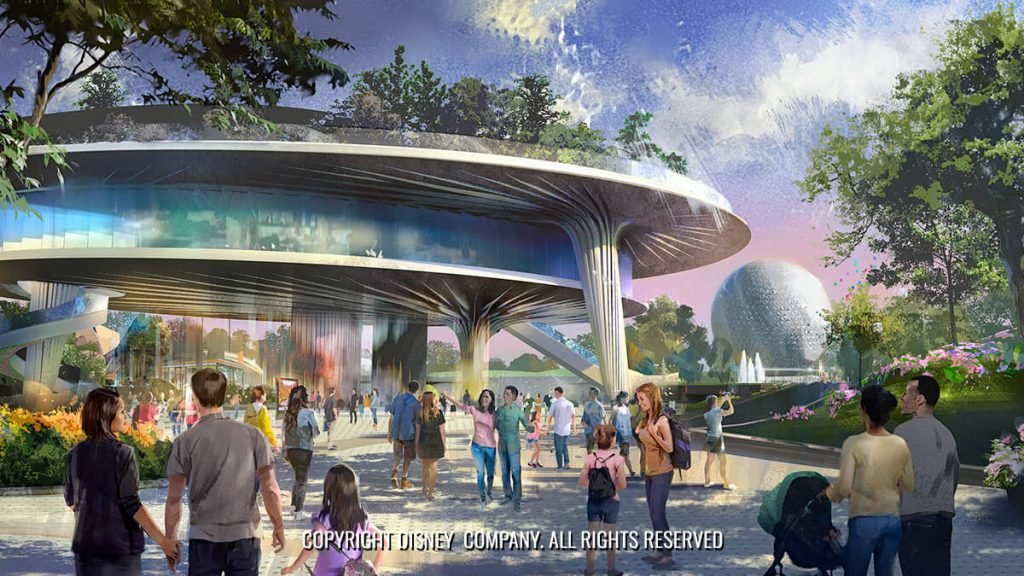
The ground level portion of this three story-tall structure was to have been known as the Plaza. Guests could easily passed through this space / directly under this building as they walked from the Creations Shop out towards World Showcase Lagoon.
As for the second floor of this structure, this was to have been the expo level. This was where various panels & presentations offered at Flower & Garden, Food & Wine, Festival of the Holidays & Festival of the Arts were to have been staged.
And as for the top floor of this three-story structure … This was the space that Disney’s Corporate Events / Special Events office was most interested in. During the day, it was supposed to be this lovely green space filled with curving walkways that then offered commanding views of Epcot (Hence its “Park in the Sky” designation).
But at night, this elevated garden would have been offered to corporate groups as a possible venue for their cocktail parties / after-convention gatherings. And these companies would have been charged top dollar for the privilege of giving their employees such a stellar view of “HarmonioUS.”
Sadly, in early May of this year, Walt Disney World announced that it had revised its plans for this corner of World Celebration. In place of that three-story tall “Park in the Sky” (which would have really made an interesting architectural statement), we’re now going to get a far more conventional-looking (more importantly, cheaper-to-build) CommuniCore Hall & CommuniCore Plaza. Which – going forward – will eventually serve as Epcot’s new festival center.
Which – I know – has to disappoint the folks at WDW’s Special Events / Corporate Event offices. They’d already begun talking with various corporations about possibly renting out Epcot’s “Park in the Sky” for their upcoming Orlando-based conventions. My understanding was that – prior to the pandemic – this three-story-tall structure was supposed to have opened no later than 2023.
CommuniCore Hall & CommuniCore Plaza
Now … From what I’m being told, the earliest that CommuniCore Hall & CommuniCore Plaza will be the Fall of 2024. And most of the corporations that had previously shown interest in staging events up on the third floor of Epcot’s proposed “Park in the Sky” are now reportedly disappointed with this new version of the festival center that’s now supposed to be built in World Celebration.
Of course, what’s kind of ironic here is that – by the time CommuniCore Hall & CommuniCore Plaza finally open in late 2024 – World ShowPlace (that originally-supposed-to-be-temporary structure) will then be old enough to celebrate its 25th anniversary.
Nothing’s quite as permanent as a temporary tent at Walt Disney World.
This article is based on research for The Disney Dish Podcast “Episode 386/387”, published on August 8 & 15, 2022. The Disney Dish Podcast is part of the Jim Hill Media Podcast Network.
Theme Parks & Themed Entertainment
Disney and Macy’s 90-Year Thanksgiving Day Parade Partnership: From Mickey’s First Balloon to Minnie’s Big Debut

Now, folks, if you’re like me, Thanksgiving just wouldn’t be the same without a coffee, a cozy seat, and Macy’s Thanksgiving Day Parade on the TV. And if you’re really like me, you’re watching for one thing: Disney balloons floating down 34th Street. Ever wondered how Mickey, Donald, and soon Minnie Mouse found their way into this beloved New York tradition? Well, grab your popcorn because we’re diving into nearly 90 years of Disney’s partnership with Macy’s.
The Very First Parade and the Early Days of Balloons
The Macy’s Thanksgiving Day Parade goes way back to 1924, but if you can believe it, balloons weren’t part of the festivities until 1927. That first lineup included Felix the Cat, a dragon, and a toy soldier, all towering above the crowds. Back then, Macy’s had a pretty wild idea to end the parade: they would let the balloons drift off into the sky, free as birds. But this wasn’t just Macy’s feeling generous. Each balloon had a message attached, offering a $100 reward (about $1,800 in today’s dollars) for anyone who returned it to the flagship store on 34th Street.
And here’s where it gets interesting. This tradition carried on for a few years, right up until 1932, when Felix the Cat almost took down a plane flying over New York City! Imagine that—you’re flying into LaGuardia, and suddenly, there’s a 60-foot balloon drifting toward your wing. Needless to say, that was the end of Macy’s “fly away” stunt, and from then on, the balloons have stayed firmly grounded after the parade ends.

1934: Mickey Mouse Floats In, and Disney Joins the Parade
It was 1934 when Mickey Mouse finally made his grand debut in the Macy’s parade. Rumor has it Walt Disney himself collaborated with Macy’s on the design, and by today’s standards, that first Mickey balloon was a bit of a rough cut. This early Mickey had a hotdog-shaped body, and those oversized ears gave him a slightly lopsided look. But no one seemed to mind. Mickey was there, larger than life, floating down the streets of New York, and the crowd loved him.
Mickey wasn’t alone that year. He was joined by Pluto, Horace Horsecollar, and even the Big Bad Wolf and Practical Pig from The Three Little Pigs, making it a full Disney lineup for the first time. Back then, Disney wasn’t yet the entertainment powerhouse we know today, so for Walt, getting these characters in the parade meant making a deal. Macy’s required its star logo to be featured on each Disney balloon—a small concession that set the stage for Disney’s long-standing presence in the parade.
Duck Joins and Towers Over Mickey
A year later, in 1935, Macy’s introduced Donald Duck to the lineup, and here’s where things got interesting. Mickey may have been the first Disney character to float through the parade, but Donald made a huge splash—literally. His balloon was an enormous 60 feet tall and 65 feet long, towering over Mickey’s 40-foot frame. Donald quickly became a fan favorite, appearing in the lineup for several years before being retired.
Fast-forward a few decades, and Donald was back for a special appearance in 1984 to celebrate his 50th birthday. Macy’s dug the balloon out of storage, re-inflated it, and sent Donald down 34th Street once again, bringing a bit of nostalgia to the holiday crowd.
A Somber Parade in 2001
Now, one of my most memorable trips to the parade was in 2001, just weeks after the 9/11 attacks. Nancy and I, along with our friends, headed down to New York, and the mood was something I’ll never forget. We watched the start of the parade from Central Park West, but before that, we went to the Museum of Natural History the night before to see the balloons being inflated. They were covered in massive cargo nets, with sandbags holding them down. It’s surreal to see these enormous balloons anchored down before they’re set free.
That year, security was intense, with police lining the streets, and then-Mayor Rudy Giuliani rode on the Big Apple float to roaring applause. People cheered his name, waving and shouting as he passed. It felt like the entire city had turned out to show their resilience. Even amidst all the heightened security and tension, seeing those balloons—brought a bit of joy back to the city.

Balloon Prep: From New Jersey’s MetLife Stadium to California’s D23 Expo
Each year before the parade, Macy’s holds a rehearsal event known as Balloon Fest at MetLife Stadium in New Jersey. This is where handlers get their first crack at guiding the balloons, practicing with their parade masters, and learning the ropes—literally. It’s an entire production unto itself, with dozens of people rehearsing to make sure these enormous inflatables glide smoothly down the streets of New York on parade day.
In 2015, Macy’s took the balloon show on the road, bringing their Buzz Lightyear balloon out to California for the D23 Expo. I was lucky enough to be there, and watching Buzz get inflated piece by piece in the Anaheim Convention Center parking lot was something to behold. Each section was filled with helium in stages, and when they got around to Buzz’s lower half, well, there were more than a few gas-related jokes from the crowd.
These balloons seem to have a personality all their own, and seeing one like Buzz come to life up close—even outside of New York—had all the excitement and anticipation of the real deal.

Mickey’s Comeback as a Bandleader and Sailor Mickey
After a long hiatus, Mickey Mouse made his return to the Macy’s parade in 2000, this time sporting a new bandleader outfit. Nine years later, in 2009, Sailor Mickey joined the lineup, promoting Disney Cruise Line with a nautical twist. Over the past two decades, Disney has continued to enchant parade-goers with characters like Buzz Lightyear in 2008 and Olaf from Frozen in 2017. These balloons keep Disney’s iconic characters front and center, drawing in both longtime fans and new viewers.
But ever wonder what happens to the balloons after they reach the end of 34th Street? They don’t just disappear. Each balloon is carefully deflated, rolled up like a massive piece of laundry, and packed into storage bins. From there, they’re carted back through the Lincoln Tunnel to Macy’s Parade Studio in New Jersey, where they await their next flight.

Macy’s Disney Celebration at Hollywood Studios
In 1992, Macy’s took the spirit of the parade down to Disney-MGM Studios in Orlando. After that year’s parade, several balloons—including Santa Goofy, Kermit the Frog, and Betty Boop—were transported to Hollywood Studios, re-inflated, and anchored along New York Street as part of a holiday display. Visitors could walk through this “Macy’s New York Christmas” setup and see the balloons up close, right in the middle of the park. While this display only ran for one season, it paved the way for the Osborne Family Spectacle of Dancing Lights, which became a holiday staple at the park for years to come.

Minnie Mouse’s Long-Awaited Debut in 2024
This year, Minnie Mouse will finally join the parade, making her long-overdue debut. Macy’s is rolling out the red carpet for Minnie’s arrival with special pop-up shops across the country, where fans can find exclusive Minnie ears, blown-glass ornaments, T-shirts, and more to celebrate her first appearance in the Thanksgiving Day Parade.

For those lucky enough to catch the parade this year, you’ll see Minnie take her first float down 34th Street, decked out in her iconic red bow and polka-dot dress. Macy’s and Disney are also unveiling a new Disney Cruise Line float honoring all eight ships, including the latest, the Disney Treasure.
As always, I’ll be watching from my favorite chair, coffee in hand, as Minnie makes her grand entrance. The 98th annual Macy’s Thanksgiving Day Parade airs live on NBC, and it’s a tradition you won’t want to miss—whether you’re on 34th Street or tuning in from home.
Theme Parks & Themed Entertainment
Disney’s Forgotten Halloween Event: The Original Little Monsters on Main Street

When most Disney fans think of Halloween in the parks, they immediately picture Mickey’s Not-So-Scary Halloween Party at Walt Disney World or the Oogie Boogie Bash at Disneyland Resort. But before those events took over as the must-attend spooky celebrations, there was a little-known event at Disneyland called Little Monsters on Main Street. And its origins? Well, they go all the way back to the 1980s, during a time when America was gripped by fear—the Satanic Panic.

You see, back in the mid-1980s, parents were terrified that Halloween had become dangerous. Urban legends about drug-laced candy or razor blades hidden in apples were widespread, and many parents felt they couldn’t let their kids out of sight for even a moment. Halloween, which was once a carefree evening of trick-or-treating in the neighborhood, had suddenly become a night filled with anxiety.
This is where Disneyland’s Little Monsters on Main Street came in.

The Origins of Little Monsters on Main Street
Back in 1989, the Disneyland Community Action Team—later known as the VoluntEARS—decided to create a safe, nostalgic Halloween experience for Cast Members and their families. Many schools in the Anaheim area were struggling to provide basic school supplies to students, and the VoluntEARS saw an opportunity to combine a safe Halloween with a charitable cause. Thus, Little Monsters on Main Street was born.
This event was not open to the general public. Only Disneyland Cast Members could purchase tickets, which were initially priced at just $5 each. Cast Members could bring their kids—but only as many as were listed as dependents with HR. And even then, the park put a cap on attendance: the first event was limited to just 1,000 children.

A Unique Halloween Experience
Little Monsters on Main Street wasn’t just another Halloween party. It was designed to give kids a safe, fun environment to enjoy trick-or-treating, much like the good old days. On Halloween night in 1989, kids in costume wandered through Disneyland with their pillowcases, visiting 20 different trick-or-treat stations. They also had the chance to ride a few of their favorite Fantasyland attractions, all after the park had closed to the general public.
The event was run entirely by the VoluntEARS—about 200 of them—who built and set up all the trick-or-treat stations themselves. They arrived at Disneyland before the park closed and, as soon as the last guest exited, they began setting up stations across Main Street, Adventureland, Frontierland, Fantasyland, and Tomorrowland. The event ran from 7:30 to 9:30 p.m., and by the time the last pillowcase-wielding kid left, the VoluntEARS cleaned everything up, making sure the park was ready for the next day’s operations.
It wasn’t just candy and rides, though. The event featured unique entertainment, like a Masquerade Parade down Main Street, U.S.A., where kids could show off their costumes. And get this—Disneyland even rigged up a Cast Member dressed as a witch to fly from the top of the Matterhorn to Frontierland on the same wire that Tinker Bell uses during the fireworks. Talk about a magical Halloween experience!
The Haunted Mansion “Tip-Toe” Tour
Perhaps one of the most memorable parts of Little Monsters on Main Street was the special “tip-toe tour” of the Haunted Mansion. Now, Disneyland’s Haunted Mansion can be a pretty scary attraction for younger kids, so during this event, Disney left the doors to the Stretching Room and Portrait Gallery wide open. This allowed kids to walk through and peek at the Haunted Mansion’s spooky interiors without actually having to board the Doom Buggies. For those brave enough to ride, they could, of course, take the full trip through the Haunted Mansion—or they could take the “chicken exit” and leave, no harm done.

Growing Success and a Bigger Event
Thanks to the event’s early success, Little Monsters on Main Street grew in size. By 1991, the attendance cap had been raised to 2,000 kids, and Disneyland added more activities like magic shows and hayrides. They also extended the event’s hours, allowing kids to enjoy the festivities until 10:30 p.m.
In 2002, the event moved over to Disney California Adventure, where it could accommodate even more kids—up to 5,000 in its later years. The name was also shortened to just Little Monsters, since it was no longer held on Main Street. This safe, family-friendly Halloween event continued for several more years, with the last mention of Little Monsters appearing in the Disneyland employee newsletter in 2008. Though some Cast Members recall the event continuing until 2012, it eventually made way for Disney’s more public-facing Halloween events.

From Little Monsters to Mickey’s Not-So-Scary and Oogie Boogie Bash
Starting in the early 2000s, Disney began realizing the potential of Halloween-themed after-hours events for the general public. These early versions of Mickey’s Halloween Party and Mickey’s Halloween Treat eventually evolved into today’s Mickey’s Not-So-Scary Halloween Party and Oogie Boogie Bash. Unfortunately, this also marked the end of the intimate, Cast Member-exclusive Little Monsters event, but it paved the way for the large-scale Halloween celebrations we know and love today.
While it’s bittersweet to see Little Monsters on Main Street fade into Disney history, its legacy lives on through these modern Halloween parties. And even though Cast Members now receive discounted tickets to Mickey’s Not-So-Scary and Oogie Boogie Bash, the special charm of an event created specifically for Disney’s employees and their families remains something worth remembering.
The Merch: A Piece of Little Monsters History
For Disney collectors, the exclusive merchandise created for Little Monsters on Main Street is still out there. You can find pins, name tags, and themed pillowcases on sites like eBay. One of the coolest collectibles is a 1997 cloisonné pin set featuring Huey, Dewey, and Louie dressed as characters from Hercules. Other sets paid tribute to the Main Street Electrical Parade and Pocahontas, while the pillowcases were uniquely designed for each year of the event.

While Little Monsters on Main Street may be gone, it’s a fascinating piece of Disneyland history that played a huge role in shaping the Halloween celebrations we enjoy at Disney parks today.
Want to hear more behind-the-scenes stories like this? Be sure to check out I Want That Too, where Lauren and I dive deep into the history behind Disney’s most beloved attractions, events, and of course, merchandise!
Theme Parks & Themed Entertainment
The Story of Mickey’s Not-So-Scary Halloween Party: From One Night to a Halloween Family Tradition

The spooky season is already in full swing at Disney parks on both coasts. On August 9th, the first of 38 Mickey’s Not-So-Scary Halloween Party (MNSSHP) nights for 2024 kicked off at Florida’s Magic Kingdom. Meanwhile, over at Disney California Adventure, the Oogie Boogie Bash began on August 23rd and is completely sold out across its 27 dates this year.
Looking back, it’s incredible to think about how these Halloween-themed events have grown. But for Disney, the idea of charging guests for Halloween fun wasn’t always a given. In fact, when the very first Mickey’s Not-So-Scary Halloween Party debuted on October 31, 1995, it was a modest one-night-only affair. Compare that to the near month-long festivities we see today, and it’s clear that Disney’s approach to Halloween has evolved considerably.
A Not-So-Scary Beginning
I was fortunate enough to attend that very first MNSSHP back in 1995, along with my then 18-month-old daughter Alice and her mom, Michelle. Tickets were a mere $16.95 (I know, can you imagine?), and we pushed Alice around in her sturdy Emmaljunga stroller—Swedish-built and about the size of a small car. Cast Members, charmed by her cuteness, absolutely loaded us up with candy. By the end of the night, we had about 30 pounds of fun-sized candy bars, making that push up to the monorail a bit more challenging.

This Halloween event was Disney’s response to the growing popularity of Universal Studios Florida’s own Halloween hard ticket event, which started in 1991 as “Fright Nights” before being rebranded as “Halloween Horror Nights” the following year. Universal’s gamble on a horror-themed experience helped salvage what had been a shaky opening for their park, and by 1993, Halloween Horror Nights was a seven-night event, with ticket prices climbing as high as $35. Universal had stumbled upon a goldmine, and Disney took notice.
A Different Approach
Now, here’s where Disney’s unique strategy comes into play. While Universal embraced the gory, scare-filled world of horror, Disney knew that wasn’t their brand. Instead of competing directly with blood and jump-scares, Disney leaned into what they did best: creating magical, family-friendly experiences.
Thus, Mickey’s Not-So-Scary Halloween Party was born. The focus was on fun and whimsy, not fear. Families could bring their small children without worrying about them being terrified by a chainsaw-wielding maniac around the next corner. This event wasn’t just a Halloween party—it was an extension of the Disney magic that guests had come to expect from the parks.
Disney had some experience with seasonal after-hours events, most notably Mickey’s Very Merry Christmas Party, which had started in 1983. But the Halloween party was different, as the Magic Kingdom wasn’t yet decked out in Halloween decor the way it is today. Disney had to create a spooky (but not too spooky) atmosphere using temporary props, fog machines, and, of course, lots of candy.
A key addition to that first event? The debut of the Headless Horseman, who made his eerie appearance in Liberty Square, riding a massive black Percheron. It wasn’t as elaborate as the Boo-to-You Parade we see today, but it marked the beginning of a beloved Disney Halloween tradition.
A Modest Start but a Big Future
That first MNSSHP in 1995 was seen as a trial run. As Disney World spokesman Greg Albrecht told the Orlando Sentinel, “If it’s successful, we’ll do it again.” And while attendance was sparse that night, there was clearly potential. By 1997, the event expanded to two nights, and by 1999, Mickey’s Not-So-Scary Halloween Party had grown into a multi-night celebration with a full-fledged parade. Today, in 2024, it’s a staple of the fall season at Walt Disney World, offering 38 nights of trick-or-treating, character meet-and-greets, and special entertainment.
Universal’s Influence

It’s interesting to reflect on how Disney’s Halloween event might never have existed without the competition from Universal. Just as “The Wizarding World of Harry Potter” forced Disney to step up their game with “Star Wars: Galaxy’s Edge,” Universal’s success with Halloween Horror Nights likely spurred Disney into action with MNSSHP. The friendly rivalry between the two parks has continually pushed both to offer more to their guests, and we’re all better off because of it.
So the next time you find yourself trick-or-treating through the Magic Kingdom, watching the Headless Horseman gallop by, or marveling at the seasonal fireworks, take a moment to appreciate how this delightful tradition came to be—all thanks to a little competition and Disney’s commitment to creating not-so-scary magic.
For more Disney history and behind-the-scenes stories, check out the latest episodes of the I Want That Too podcast on the Jim Hill Media network.
-

 History10 months ago
History10 months agoThe Evolution and History of Mickey’s ToonTown
-

 History11 months ago
History11 months agoUnpacking the History of the Pixar Place Hotel
-

 History11 months ago
History11 months agoFrom Birthday Wishes to Toontown Dreams: How Toontown Came to Be
-

 Film & Movies8 months ago
Film & Movies8 months agoHow Disney’s “Bambi” led to the creation of Smokey Bear
-

 News & Press Releases10 months ago
News & Press Releases10 months agoNew Updates and Exclusive Content from Jim Hill Media: Disney, Universal, and More
-

 Merchandise8 months ago
Merchandise8 months agoIntroducing “I Want That Too” – The Ultimate Disney Merchandise Podcast
-

 Theme Parks & Themed Entertainment3 months ago
Theme Parks & Themed Entertainment3 months agoDisney’s Forgotten Halloween Event: The Original Little Monsters on Main Street
-

 Film & Movies3 months ago
Film & Movies3 months agoHow “An American Tail” Led to Disney’s “Hocus Pocus”

